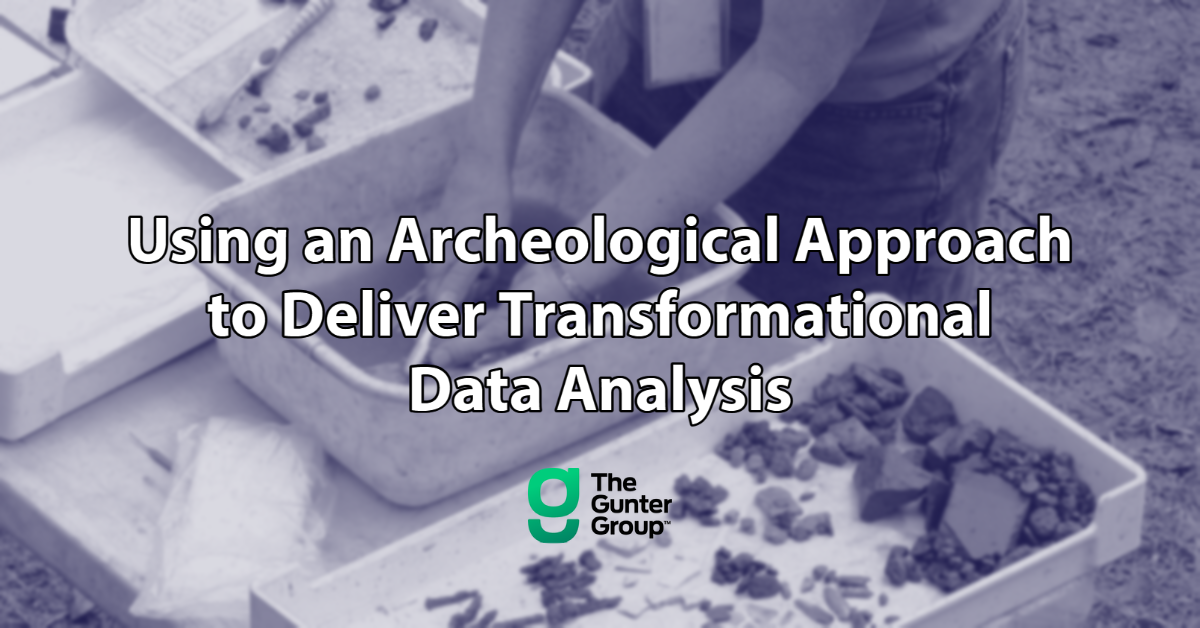USING AN ARCHEOLOGICAL APPROACH TO DELIVER TRANSFORMATIONAL DATA ANALYSIS

Archeologists seek to understand human behavior through stuff – physical stuff. These artifacts of human existence are often ravaged by time, leaving the subtlest of clues for us to examine. Without context, archaeologists piece together the puzzle and hypothesize why humans of the past made certain decisions and how they interacted with each other and their environment.
As a former archaeologist, I’ve transitioned from the academic world into management consulting. At first glance, the two may seem unrelated but I’ve discovered that my background gives me a unique perspective and a surprisingly transferable skill set. I certainly know my way around a transected excavation pit and a trowel, but the skills I’m talking about are more akin to business intelligence, behavior science, and organizational development. Additionally, the academic discipline itself, like most in the liberal arts, provided an incredibly strong interdisciplinary education and honed my ability to learn new things and synthesize complex data quickly.
I dug deeper to uncover the sweet spot at which wait times, volume, and customer loyalty could work in harmony to optimize results.
Archaeological education, training, fieldwork, and research commonly incorporate a wide range of disciplines, from botany and geology to sociology and economics. One day I might read a dense medical journal and the next study climate data, all while making novel connections to illuminate meaningful patterns. By now, I’m sure you can see how this would translate to a more corporate setting where business analysts, data scientists, and market strategists regularly flex the same muscles. What I love most about consulting is taking these insights and the scientific method and turning them into action so clients can better predict, understand, and adapt to their customers’ behavior.
For example, I recently helped a client understand how wait times impacted the customer experience and subsequent loyalty. Their assumption was that lower volume would reduce wait time thereby increasing volume again. I rolled up my sleeves to excavate their data and find out if this proved true. It turned out to be more complicated than that so I dug deeper to uncover the sweet spot at which wait times, volume, and customer loyalty could work in harmony to optimize results.
Such a dynamic situation can be difficult to articulate so I leveraged a commonly used framework developed by in-depth ecological research: the predator/prey model. When applied to the above business scenario, our analysis revealed a pattern that led us to actionable insights. We determined the retail equivalent of “ecosystem equilibrium” which indicated an ideal range for how long customers could be kept waiting without negatively impacting loyalty. We are currently testing our hypothesis of the maximum theoretical wait time in the real world. By engineering specific wait times, they will be able to collect additional data which will then be fed back into our model and drive continuous improvement.
Another recent example of archaeological expertise adapted to the business world comes from our work with a large retailer. This client was puzzled as to why one location showed double the sales compared to another only a mile away. Customer profiles, inventory, staffing, etc. were all so similar so why the disparity?
Suddenly customer behavior made complete sense and store managers were able to direct their attention to the right issues and avoid unnecessary time and expense trying to solve the wrong problem.
For this scenario, I invoked another scientific model: least cost pathways. The least cost pathways model essentially helps us determine the path of least resistance using weighted costs associated with various routes. In archaeology, this model might help explain seemingly odd trade patterns or dietary choices. In a modern business scenario, the same approach can be used to map human movement, both physical and virtual, and optimize location of brick-and-mortar stores, button placement on a website, or product placement on a shelf.
Through this lens, our analysis revealed that the under performing store required a U-turn and a left hand turn across four lanes of traffic. Meanwhile, the other store required only an easy right hand turn off a freeway entrance. Given this information, which location would you choose to do your shopping? Suddenly customer behavior made complete sense and store managers were able to direct their attention to the right issues and avoid unnecessary time and expense trying to solve the wrong problem. Going forward, executives have revised their strategy for key real estate and business decisions to incorporate these insights and avoid costly mistakes.
The potential of data analysis, especially in this age of “big data,” is immense but it’s important to use appropriate models to help explain that data and to ask the right questions in the first place. By thinking like an archeologist and working like a data scientist, I’m able to solve puzzles that save clients time and money.
